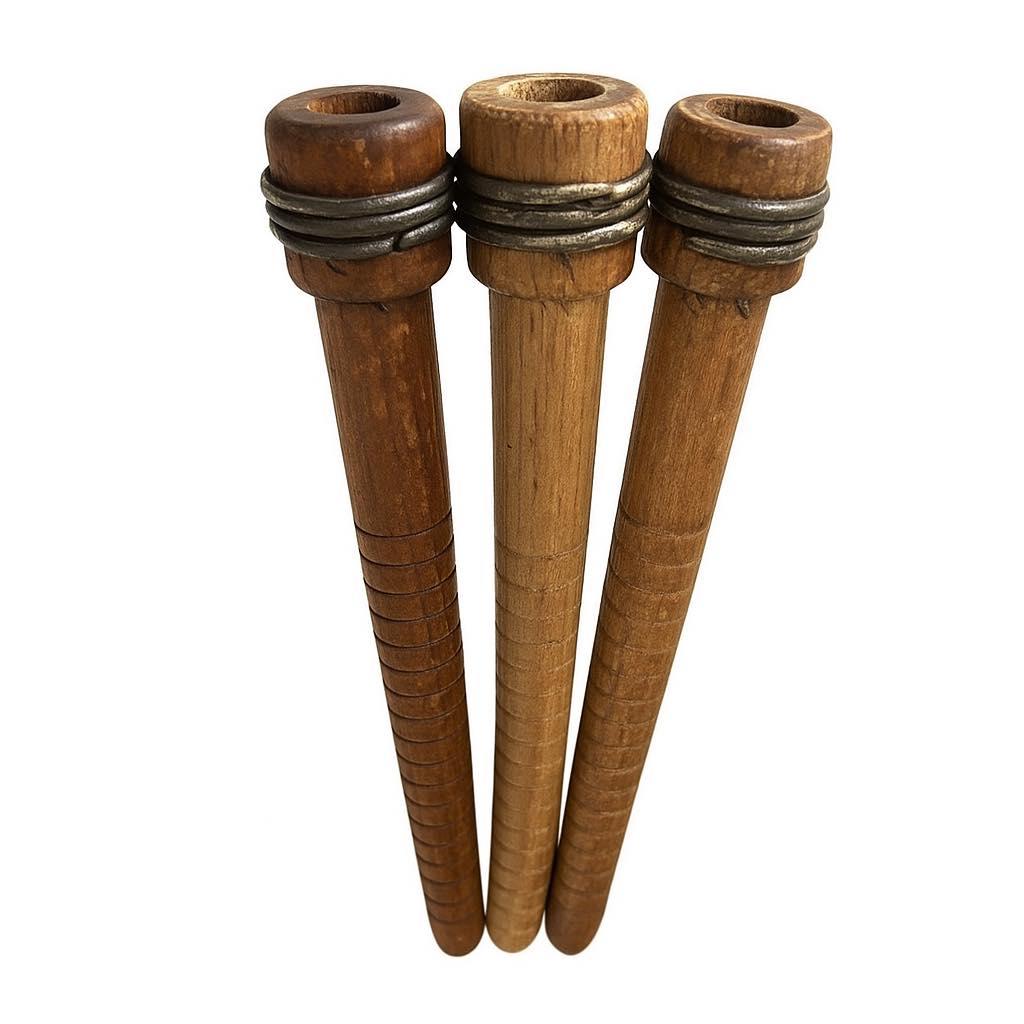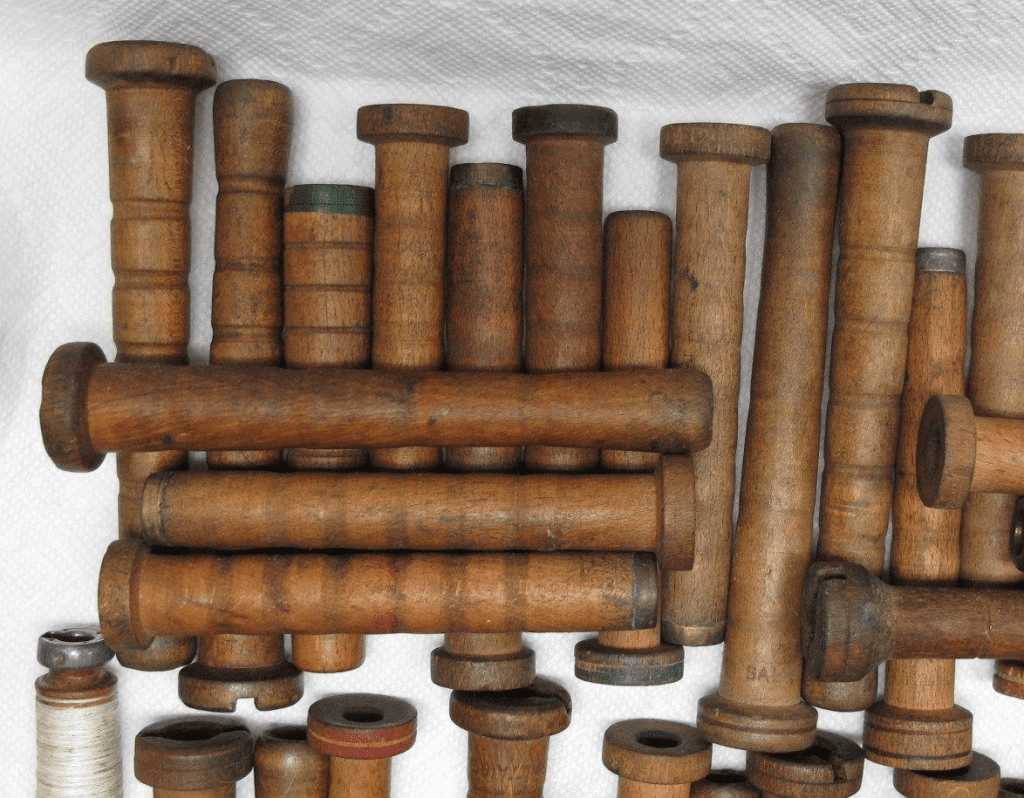Echoes of Industry: The Story Behind the Wooden Spool That Wove the World
It may look simple—just a piece of wood shaped into a spindle—but for nearly a century, this object powered one of humanity’s greatest revolutions. These are wooden thread spools, also known as textile mill bobbins or loom spindles. Once the heartbeat of the Industrial Age, they carried the fibers that clothed nations, symbolizing craftsmanship, precision, and the beauty of early machinery.
From Humble Wood to Industrial Marvel
Before plastic and automation, wood ruled the textile mills. These spools were typically made from hardwoods like oak, maple, or birch—materials chosen for their strength and ability to endure endless hours of spinning and friction. Their design was both functional and elegant: a hollow center for fitting onto a spindle, metal bands to prevent wear, and fine grooves along the shaft to grip thread without slippage.

Every spool was crafted with care. Even though they were mass-produced, artisans shaped and balanced them by hand. Each one had a slightly unique character—a reminder that human touch once guided every stage of production.
Born in the Age of Steam and Steel
The story of these wooden bobbins begins in the 19th century, when textile mills rose across England, the United States, and Europe. The Industrial Revolution turned weaving from an art into an empire, and these spools were its soldiers. They carried cotton, silk, wool, and linen across the roaring floors of factories lit by oil lamps and powered by steam.
Workers—often young women—would load them into spinning frames and looms, where threads raced at blinding speeds. The hum of thousands of bobbins spinning at once became the song of progress. Imagine standing in those mills, the air thick with cotton dust, the rhythm of machines pounding like a heartbeat.
For the workers, each spool represented not just labor, but livelihood—a small tool connecting them to an industry that clothed the world.
Video : Peering into the Past: Antique Wooden Spools
A Design Built to Endure
These spools were masterpieces of simple engineering. Their form evolved to meet the demands of ever-faster machines. The metal rings around their tops weren’t just decoration—they protected the wood from splitting under friction and heat. The carved grooves weren’t aesthetic—they held the delicate thread in place as it spun.
Durability was everything. A good spool could last years in a mill before being retired, often repurposed by craftsmen or passed on as keepsakes. That’s why, even after decades, many still survive—scarred, darkened, but intact.
Symbols of a Bygone Era
By the mid-20th century, progress replaced wood with plastic and aluminum. The new materials were cheaper, lighter, and could withstand higher speeds. The wooden spools, once indispensable, began disappearing from factory floors.
But history has a way of preserving beauty. Collectors and artisans rediscovered these relics, valuing them not for what they did, but for what they represent. Today, they appear in antique markets, home décor, and even art installations—each one whispering stories of the workers who touched them, the machines they powered, and the era they helped build.

Some are polished and displayed on mantels. Others are left raw, their patina of oil and age telling their own truth. In every form, they carry the warmth of craftsmanship and the weight of history.
The Artistry of Utility
What makes these spools so captivating today isn’t just nostalgia—it’s design. They embody an era when utility and beauty coexisted naturally. Every curve, ring, and ridge was made for a purpose, yet the result feels artistic. In an age obsessed with perfection, these handcrafted pieces remind us that imperfection is charm.
They’ve found new lives as candle holders, photo props, or bases for lamps. Artists use them to wind colored threads or yarns again, giving new purpose to old tools. Each reinvention honors the past while keeping it alive in the present.
Echoes from the Mill
Picture it: the clang of metal, the spin of gears, the steady rhythm of hundreds of spindles turning side by side. The air hums with energy, and in every hand, one of these small wooden spools spins another thread of history. That was the pulse of the 19th-century textile world—a world powered by human hands and mechanical brilliance.
Though silent now, these spools remain storytellers. They connect us to generations who built modern life thread by thread. Every nick and groove is a reminder that progress was once handmade.
Video : Process of Making Wooden Bobbins to use Weaving Power Looms | Amazing Woodworking Process
Conclusion: Threads That Never Broke
The wooden spool is more than an antique—it’s a bridge between centuries. Born in the age of steam and sweat, it carried the fabric of human industry and creativity. Even as modern materials took over, its legacy endured, reminding us that innovation begins with craftsmanship and care.
Today, when you hold one in your hand, you’re holding more than wood and metal—you’re holding time itself. It’s a quiet relic from an age when every object had purpose, every craft had pride, and every thread connected people across the world.
Because history isn’t just written in books—it’s carved, turned, and polished into the simplest of things.